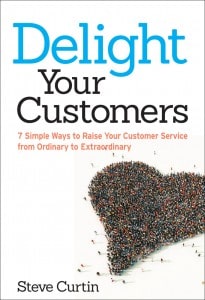 The following post contains a recent interview by Erica Marois of ICMI:
The following post contains a recent interview by Erica Marois of ICMI:
1. In your book you mention that 80% of companies claim to provide superior service, while only 8% of customers agree. Where are companies missing the mark?
Too many companies focus exclusively on teaching their employees WHAT to do (imparting job knowledge) and HOW to do it (developing job skills), but neglect any reference to WHY they are doing it (conveying job purpose; employees’ highest priority at work). As a result, most companies produce competent employees who, while capable of consistently executing the mandatory job functions for which they are paid, are aloof: unaware of organizational purpose, uninformed about business priorities and objectives, and uninspired at work.
2. Recent ICMI research revealed that a majority of contact center leaders are knowingly preventing their agents from providing the best customer experience possible (they’re not empowering them with the tools they need). Why do you think this is the case?
There is a halo effect that suggests company leaders are somehow enlightened beyond the degree to which their frontline employees are enlightened. By “enlightened” I’m referring to having a shared understanding of their work’s meaning and purpose. Just because someone is a manager doesn’t mean that he/she is aware of organizational purpose. If managers are themselves ignorant about purpose, then how can they be expected to inspire their staff to achieve their organization’s highest priority? Disclaimer: Having said that, I disagree that employees are justified in delivering a subpar customer experience on the basis that their manager is unsupportive. Excellence doesn’t require permission. You are not given initiative by your manager; you take it yourself.
3. As a customer, what’s the worst service experience you’ve had recently?
I recently phoned my local supermarket upon discovering that $13.30 worth of sliced roast beef from the deli that appeared on my receipt did not make it into my shopping bags. After conveying this to the employee who answered my call, he said, “Could you call back at a more convenient time?” Seriously?
4. What’s the best experience?
Just today, I had a two-man installation crew from Ferguson Enterprises install three appliances: a gas cooktop, a retractable downdraft, and a double oven. They showed up on time, completed an expert installation within 2.5 hours, left no mess behind, and were courteous and professional. Now, you might be thinking: “Huh? Is that it? It sounds like they just did their jobs really well. Where’s the outrageous customer service gesture?” There was none. There didn’t have to be. My definition of customer service is this: a voluntary act that demonstrates a genuine desire to satisfy, if not delight, a customer. (Notice how it doesn’t read: “…genuine desire to delight a customer”?) There is a popular misconception that breathless, over-the-top customer service is required in order to achieve the reputation of a heralded customer service provider like Zappos or Nordstrom. The reality is that this type of service model leads to employee (and quite possibly, customer) fatigue and is, over time, unsustainable. Customers do not expect employees to go out of their way during every interaction. Most customers simply want to receive the product or service ordered at the time and price expected.
5. Many people now argue that delighting customers isn’t as important as making their experience easy. What do you think?
The people who make this argument assume that it has to be zero-sum: either delight customers or reduce customer effort. As most reasonable customer experience professionals understand, it doesn’t have to be one or the other; it can be both. In fact, as a customer myself, I’m “delighted” whenever a service provider reduces the effort I have to expend during a transaction. And I’m sure I’m not alone.
6. How much do you think customer expectations have changed in the last 10 years?
Expectations are based, in part, on our experiences. Before the proliferation of social media and review websites over the past decade, customers’ expectations were based on their personal experiences with a product or service or, perhaps, a review they happened across in the media or heard from a family member, friend, or colleague. Today, customers don’t have to happen across a review or bump into another person with first-hand experience; they can actively search for online reviews and form expectations based on others’ experiences. The result is that today’s customers are better informed and adjust their expectations accordingly.
7. Customer Service Week will be here before we know it. What’s one cool, low-cost way teams can celebrate this year?
Here’s my opinion about Customer Service Week: some companies will spend more time and effort staging events in preparation for Customer Service Week than they will spend celebrating customers and delivering exceptional customer service during the remaining 51 weeks of the year. Customer service is not a campaign; it’s a commitment. What’s one cool, low-cost way teams can celebrate this year? How about committing to celebrate the customer 52 weeks out of the year by consistently expressing genuine interest in serving them? It costs nothing to smile, make eye contact, add energy to your voice, display a sense of urgency, pay attention to detail, anticipate needs, follow-up, etc.
If you have an opinion about any of these questions, or my responses, please share it in the comments section. Thanks!



